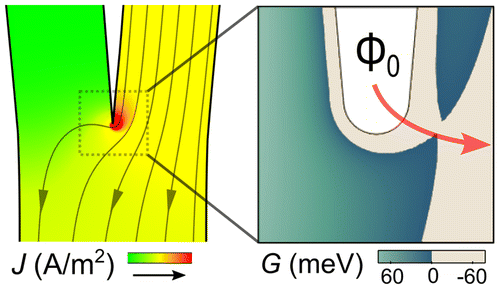News
New publication: “Using Geometry to Sense Current”
We describe a superconducting three-terminal Y-shaped device that uses a simple geometric effect known as current crowding to sense the flow of current and actuate a readout signal. A complete description of the publication may be found here.

Citation:
Adam N. McCaughan, Nathaniel S. Abebe, Qing-Yuan Zhao, and Karl J. Berggren. “Using geometry to sense current.” Nano Lett., Article ASAP., Manuscript DOI: 10.1021/acs.nanolett.6b03593. Available Online: November 29, 2016
Adam McCaughan awarded 2016 Jin-Au Kong Award for outstanding PhD thesis in EE
Congratulations to Adam McCaughan for being awarded the 2016 Jin-Au Kong Award for outstanding PhD thesis in electrical engineering. Adam’s thesis, titled, “Superconducting Thin Film Nanoelectronics,” describes his work on developing novel superconducting devices by nano-patterning thin films into 2D geometries for applications including amplification, metrology, and sensing. More information about this award may be found here.
Professor Berggren awarded the Frank Quick Research Innovation Fellowship
Congratulations to Professor Berggren on being awarded the Frank Quick Research Innovation Fellowship (FRIF). The FRIF was created through the generosity of EECS alumnus Frank Quick ’69, SM ’70 to recognize midcareer faculty for outstanding research contributions and international leadership in their fields. Prof. Berggren has been recognized for his work on nanofabrication, especially applied to superconductive sensors and circuits, photodetectors, electronics and computing, and energy systems. Read more about this award and the other MIT faculty who were awarded the FRIF here.
Seeking Graduate Research Assistant in superconducting-nanowire based electronics
Developing superconducting-nanowire based electronics
We are looking for a graduate research assistant (must be an admitted MIT graduate student) to develop novel quantum sensors, logic devices and digital circuits based on superconducting nanowires. Present projects can support students to develop their skills from designing and fabricating electronics to constructing working systems, which are aimed to various applications, such as quantum information science and energy-efficient classical computation. The initial emphasis of the work will be on the investigation of working principles of superconducting nanowires and development of superconducting circuits based on the nanowire-based electronics.
Interested candidates may apply at http://goo.gl/forms/mleVXYlfWydeymej2.
Seeking post-doctoral candidate in electron optics and nanofabrication
Post-doctoral candidate sought with experience suitable to performing research in one or more of the following areas: design of electron optics, numerical simulation of electromagnetic fields and electron trajectories in electric fields, plasmonics, nanofabrication including electron/ion beam lithography, transmission-electron microscopy or holography, electron energy-loss spectroscopy, and quantum optics. The new hire will assist in with the planning and management of the group activities, especially in mentoring graduate and undergraduate students, planning and executing research programs, and raising funds for research. The post-doc will have an opportunity to work with a small international team of researchers to develop a new electron microscope based on quantum non-demolition measurements (Kruit et al. Designs for a quantum electron microscope, Ultramicroscopy 2016, 164, 31), as well as the opportunity to collaborate on other ongoing and new projects in our research group. The candidate must have a Ph.D. in Physics, Electrical or Mechanical Engineering, Chemistry, Materials Science, Applied Physics, or a related field. The initial emphasis of the work will be on the demonstration of quantum-mechanically coherent electron resonators to demonstrate the proof of concept of the effect.
Interested candidates may apply at http://goo.gl/forms/mleVXYlfWydeymej2. If this link is unavailable to you for any reason (some geographic locations block google forms), you may contact Dorothy Fleischer (dotf@mit.edu) for assistance in completing the form.Applications will be evaluated as received, with a candidate selection and appointment expected in the Fall of 2016.